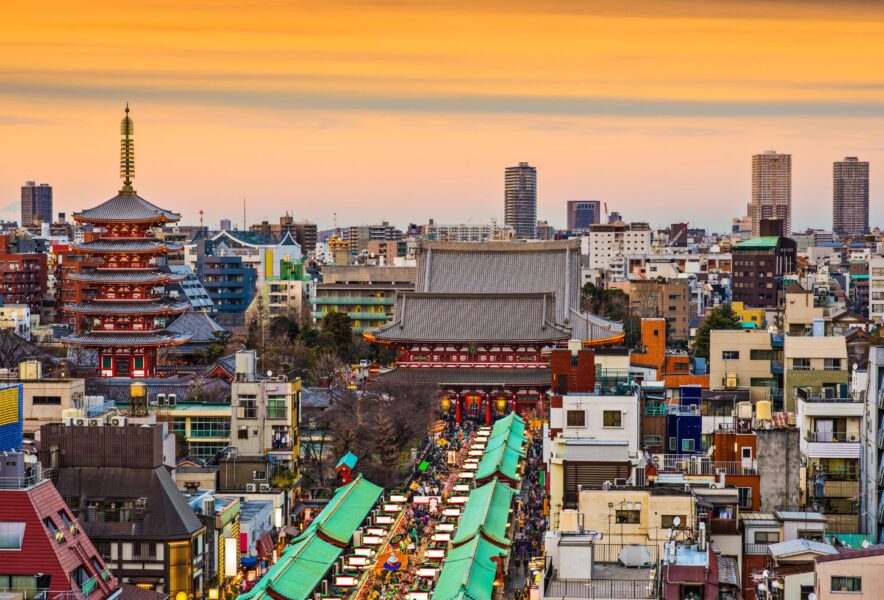Asakusa, one of Tokyo’s most historic districts, offers a unique blend of traditional Japanese culture and modern experiences. This guide is perfect for first-time visitors, highlighting Asakusa’s top attractions, from ancient temples to scenic river cruises. Whether you’re a history enthusiast or looking for a fun day out, Asakusa offers something for everyone.
- Senso-ji Temple: Tokyo’s Oldest and Most Iconic Temple
- Nakamise Street: Shop and Snack Your Way Through History
- Asakusa Culture and Tourist Information Center: A Hidden Gem for Views
- Sumida River and Asakusa River Cruise: Scenic Views of Tokyo
- Asakusa Hanayashiki: Japan’s Oldest Amusement Park
- Bonus Tip: Asakusa’s Seasonal Festivals
Senso-ji Temple: Tokyo’s Oldest and Most Iconic Temple
Senso-ji Temple, also known as Asakusa Kannon Temple, is the heart of the district and one of Tokyo’s most visited landmarks. Founded in 628 AD, it is Tokyo’s oldest temple and is dedicated to Kannon, the Buddhist goddess of mercy. Entering through the famous Kaminarimon (Thunder Gate), with its massive red lantern, is an experience in itself. The gate is guarded by two statues—Fujin (the god of wind) and Raijin (the god of thunder)—which stand as protectors of the temple. The temple grounds are equally impressive, with the towering five-story pagoda and the serene Asakusa Shrine nearby.
Visitors often take part in the omikuji fortune-telling ritual or buy omamori protective charms, which come in different varieties for good health, love, and success. The temple is a stunning sight both during the day and at night when it is beautifully illuminated, providing ample opportunities for photographers and history enthusiasts alike.
Nakamise Street: Shop and Snack Your Way Through History
The Nakamise Shopping Street is one of the oldest shopping streets in Japan, stretching from Kaminarimon to Senso-ji. It has been bustling since the Edo period, offering about 90 shops filled with souvenirs like yukata (light cotton kimonos), folding fans, traditional chopsticks, and Japanese sweets. The street is a delight for food lovers, offering a range of local snacks. You’ll want to try the taiyaki (fish-shaped cakes filled with custard or red bean paste), senbei (rice crackers), and the ever-popular ningyo-yaki (small doll-shaped sponge cakes filled with sweet red bean paste).
The vibrant atmosphere of Nakamise, with its colorful lanterns and traditional storefronts, makes it the perfect spot for shopping, eating, and taking photos. It’s a great place to immerse yourself in the local culture and bring home authentic souvenirs.
Asakusa Culture and Tourist Information Center: A Hidden Gem for Views
Located just across from Kaminarimon, the Asakusa Culture and Tourist Information Center is an often-overlooked gem. The building, designed by renowned architect Kengo Kuma, features an 8th-floor observation deck that offers panoramic views of Asakusa, including Senso-ji, the Sumida River, and the nearby Tokyo Skytree.
In addition to the stunning views, the center is also a valuable resource for tourists, offering multilingual guides, free maps, and information on local events and attractions. The building often hosts exhibitions about the history of Asakusa and traditional Japanese culture. The blend of modern architecture and historical surroundings makes this an excellent spot for both learning and capturing memorable photos.
Sumida River and Asakusa River Cruise: Scenic Views of Tokyo
Taking a Sumida River Cruise offers a peaceful way to see Tokyo from a different perspective. The cruises depart from Asakusa and glide along the Sumida River, passing under historic bridges and offering close-up views of landmarks such as Tokyo Skytree and the Asahi Beer Hall—famous for its golden flame sculpture, which, when I first saw it, honestly looked like a giant golden poop! Despite the humorous nickname it has earned, the sculpture is an iconic part of the Asakusa skyline.
The river cruise is a relaxing way to unwind after exploring the busy streets of Asakusa, providing an opportunity to appreciate the city’s mix of modern and traditional elements from the water. Many cruises also offer routes to popular destinations like Odaiba or Hamarikyu Gardens, making it a convenient option for those looking to explore more of Tokyo.
Asakusa Hanayashiki: Japan’s Oldest Amusement Park
No trip to Asakusa is complete without a visit to Hanayashiki, Japan’s oldest amusement park, which first opened in 1853. Located just a short walk from Senso-ji Temple, this retro park is filled with nostalgic charm. It features vintage rides, such as Japan’s oldest roller coaster, a classic Ferris wheel, and other old-school attractions that evoke a sense of Tokyo’s past. The park’s laid-back atmosphere is a stark contrast to the bustling streets of Asakusa, making it a great place to unwind and have fun with friends and family.
Hanayashiki is perfect for families, couples, or anyone looking to experience a slice of old Tokyo. Seasonal events, such as illuminations and festivals, keep the park lively throughout the year. Don’t forget to visit the Hanayashiki Shitamachi Shop for retro-style souvenirs that make great gifts or keepsakes from your trip.
Bonus Tip: Asakusa’s Seasonal Festivals
While exploring Asakusa’s top attractions is a must, visiting during one of the district’s famous festivals will give you an even deeper cultural experience. The Sanja Matsuri, held in May, is one of Tokyo’s most exciting Shinto festivals, featuring vibrant parades, mikoshi (portable shrines), and traditional music and dance. Another favorite is the Asakusa Samba Carnival, held every August, where the streets come alive with colorful costumes, rhythmic dancing, and lively samba music. These events showcase the heart and soul of the local community and offer an unforgettable way to experience Asakusa.

Comment